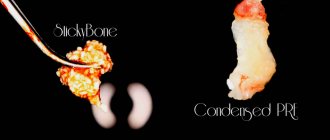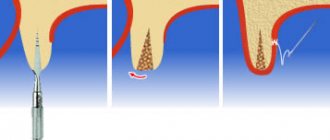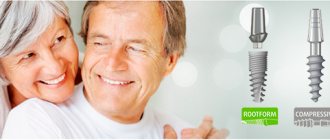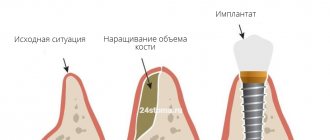What is platelet fibrin
Platelets
- flat, colorless blood cells that participate in clotting and help stop bleeding. When the integrity of a blood vessel is disrupted, platelets are destroyed and substances are released that form a blood clot or thrombus. In the 1980s, an additional property was discovered: the ability to accelerate the regeneration of damaged tissue. This occurs due to the release of peptide and steroid hormones (growth factors) that stimulate the restoration of old cells and the growth and division of new cells.
Plasma
- not just platelets, but enriched platelet fibrin. This is a pale yellow liquid formed after blood is centrifuged. It contains platelets and other biologically active substances:
- proteins (fibrin, formed from fibrinogen);
- lipids;
- hormones and hormone-like substances;
- amino acid metabolites;
- vitamins;
- minerals.
After the injection of autoplasma into the jaw bone, growth factors are activated and gradually released within 7 days. They improve the supply of oxygen to tissues due to the formation of a dense capillary network (neovascularization). Favorable conditions are created to normalize trophism, accelerate regeneration and activate cellular growth in the jaw bone.
Human plasma contains useful substances and is bioinert to tissues, because is a product of the same organism. For this reason, there is never any rejection or side effects from platelet concentrate injections. Injection of autoplasma provides a predictable course of the postoperative period.
What tools and equipment should I choose for plasma lifting?
Tools and equipment for obtaining autoplasma can be very different - from economy to premium class. But they all meet basic quality requirements, so the choice is yours. And we will try to highlight models that, as practice shows, attract professionals.
Centrifuge for plasma lifting EVA 200
Centrifuge for plasma lifting EVA 200 (made in Germany) is one of the most expensive on the dental equipment market.
The practical, universal benchtop centrifuge EBA 200 for plasma lifting is ideal for a variety of tasks. Maximum centrifugal acceleration and an 8-position angled rotor for tubes up to 15 ml make this model practical and versatile.
The relatively high price does not bother those who invest in their regular income.
Centrifuge for plasma lifting 80-2 Armed
The Russian-made plasmolifting centrifuge 80-2 Armed demonstrates reliable operation in clinical laboratory diagnostics for the purpose of conducting the necessary medical research.
The low price attracts potential buyers and does not in any way affect the quality of the work or its final result.
Test tubes for plasma lifting
Vacuum tubes for the PRF technique are an important attribute that allows you to quickly, easily and most comfortably carry out the blood collection procedure.
High-quality tubes meet international SE and ISO standards, prevent blood clotting, guarantee complete adsorption and fixation of red blood cells, as well as the unchanged properties of autoplasma.
Needles
In addition to high-quality tubes, the Plasmolifting procedure requires special thin needles with a special cutting angle. Their choice should be given special attention, and it is best to purchase goods from a reliable, trusted supplier.
How to obtain membranes from blood plasma - plasmapheresis procedure
Plasma therapy uses not venous blood taken from the patient, but centrifuged plasma isolated from peripheral blood. The condition of soft and bone tissues is improved through the injection of autoplasma. This autoplasma is also called PRP (platelet-rich plasma), platelet concentrate or gel.
The best results are obtained from plasma containing at least 1 million platelets per 1 μl. To obtain such a concentrate, a plasmapheresis procedure is performed:
- 15-20 ml of blood is taken from the patient’s dental office from the ulnar vein.
- A test tube with blood is run twice in a separator centrifuge for 15 minutes. This is done to separate excess fractions containing red blood cells and white blood cells.
- Fractions used in dentistry - plasma and fibrin clot - are taken from the test tube.
Platelets, fibrin and other biologically active substances are concentrated, forming thick autoplasma (platelet gel). The resulting concentrate is injected into the marginal gum, dentogingival papilla or transitional fold.
In addition, a fibrin clot (blood plasma membrane - PRF membrane) is formed in the test tube. Such a membrane can be cut and stitched for use in various techniques - osteoplasty, tooth extraction surgery after extraction to stimulate reparative processes in the socket.
Membranes for bone grafting are stored for no more than four hours, so plasmapheresis is performed on the day of surgery.
Purpose, basic properties
Fibrin I-PRF in liquid form is obtained immediately after centrifugation, but before coagulation. If you plan to use it in this form, you need to work quickly, since coagulation occurs in two to three minutes. The product is used in a variety of ways, including direct injections into the gums for the treatment of periodontitis. Such actions not only promote rapid healing and elimination of inflammation, but also help in tissue renewal.
Fibrin membranes are actively used in surgery for maxillofacial plastic surgery. For this purpose, coagulated preparations are used, helping in rapid regeneration. The technology is in demand in implantation. The use of such a coating ensures safe and rapid integration of the artificial root with the surrounding bone tissue.
The properties of drugs in liquid and coagulated form differ. The doctor must take this into account, as well as the purpose of the clot, the characteristics of the work, the condition of the tissues and other factors.
Advantages and disadvantages
The use of fibrin membranes in dentistry is practiced by surgeons in almost all countries of the world. Excellent results are confirmed by many clinical studies and the opinions of doctors themselves. The advantages of this technology include:
- postoperative wounds using a fibrin clot heal quickly, rehabilitation time is reduced;
- the pain syndrome decreases after treatment, there is no swelling, there is no discomfort;
- the risks of infection and complications are eliminated, and a hemostatic effect is observed;
- healthy tissues are preserved as much as possible, new ones are regenerated quickly;
- the technology is affordable, today it is increasingly used for dental offices and mid-segment clinics;
- it takes a minimum of time to make a clot;
- after completion of the manipulations, new vessels are formed quickly;
- autogenous drug, compatible with the Patient’s tissues;
- manufacturing requires little cost and time;
- due to the presence of leukocytes, local immunity is stimulated;
- versatility, the ability to use the drug to work with hard and soft tissues, skin, mucous membranes;
- acceleration of regeneration and healing after surgical procedures.
There are practically no contraindications or disadvantages to the membrane technology. This happens because the drug is made from the Patient’s blood, that is, there are practically no risks of rejection or the development of inflammatory processes. There are also virtually no side effects.
Application of PRF membranes for bone tissue growth
Membranes from blood plasma are not used as a separate method of osteoplasty - they are not enough to replenish the size of bone tissue in full. But they are used to prepare jaw tissue for implantation when the bone structure is unsatisfactory, preventing the installation of an implant of sufficient length. Used as an addition to osteoplastic operations (independent or prior to implantation):
- sinus lift;
- alveolar ridge augmentation;
- bone block transplantation;
- guided bone regeneration.
Splitting of the alveolar ridge Increasing the volume of bone tissue in width by adding osteomaterial inside the alveolar process
Guided bone regeneration The lack of tissue is filled with a bone substitute, which is secured with a membrane. Use proprietary or synthetic materials
Sinus lifting A bone grafting method aimed at increasing the volume of bone tissue in the upper jaw in the area of the maxillary sinuses
When osteoplasty and implantation are performed simultaneously, the membrane accelerates the processes of osseointegration and stabilization of the implant. This is an effective way to activate the process of fusion of bone materials and implants with the jawbone, since the platelet concentrate contains tissue cell growth factors in large quantities. Membranes are also used for immediate installation of implants into the socket of an extracted tooth.
Recommendations after plasma lifting
Plasmolifting is carried out in combination with other medical procedures. The duration of the rehabilitation period is determined depending on the disease and the medical procedures performed.
Recommendations for the patient to follow after treatment:
- limit physical activity during the recovery period;
- avoid exposure to high and low temperatures - baths, saunas, solariums;
- do not disturb the intervention site with your tongue and brush;
- maintain proper oral hygiene;
- temporarily eliminate hard and irritating foods and alcohol consumption.
Why else is plasma lifting done in dentistry?
In addition to osteoplasty, plasma lifting in dentistry is used in the following cases:
- generalized or localized chronic periodontitis and periodontal disease, gingivitis, resistant to other conservative dental treatment methods;
- traumatic extraction of teeth or during reposition of jaw bone fragments as a result of trauma to the maxillofacial area;
- prevention of peri-implantitis, alveolitis and periodontal inflammation;
- to accelerate tissue regeneration after vestibulo- and gingivoplasty.
Scope of application
Enriched fibrin is officially recognized as a drug with an effective effect in healing and regeneration after surgery. One of the areas where the drug is used most actively is dentistry. Membranes show excellent results in implantation, treatment of soft tissues, and bone restoration.
Areas of use:
- in case of complex tooth extraction, if there is a need to preserve bone volume, alveolar walls, and prevent complications;
- to prevent gum recession (the drug is applied to the exposed necks, preventing further deterioration);
- to perform preimplantation augmentation, including in case of hard tissue deficiency;
- as a coating for artificial roots during implantation (used to accelerate the integration of the implant into the bone);
- during closed or open sinus lifting;
- for immediate implantation, to stabilize the rod after screwing in;
- performing patchwork surgical interventions, including recession of gum tissue, sinus lifting, elimination of various types of defects, wound therapy;
- rapid healing during maxillofacial plastic surgery, prevention of complications.











